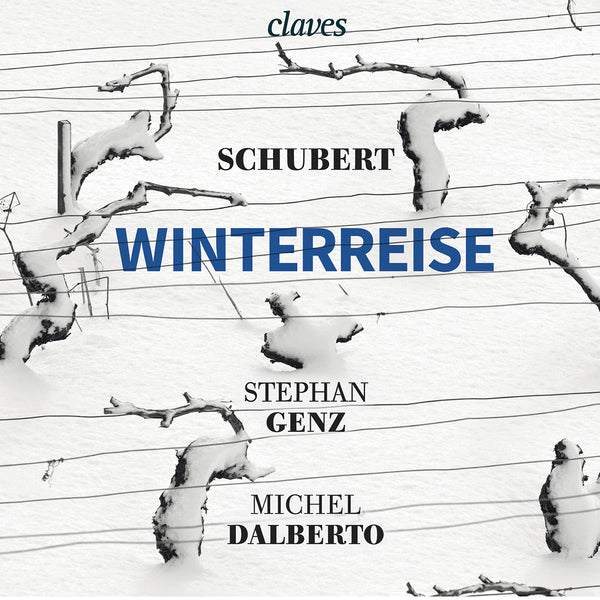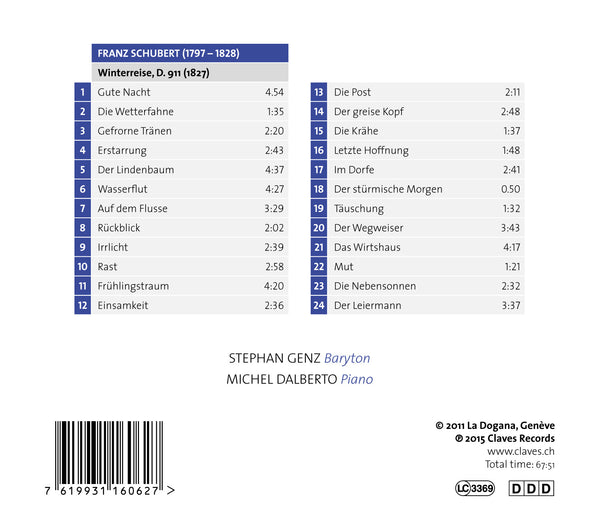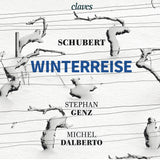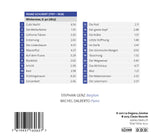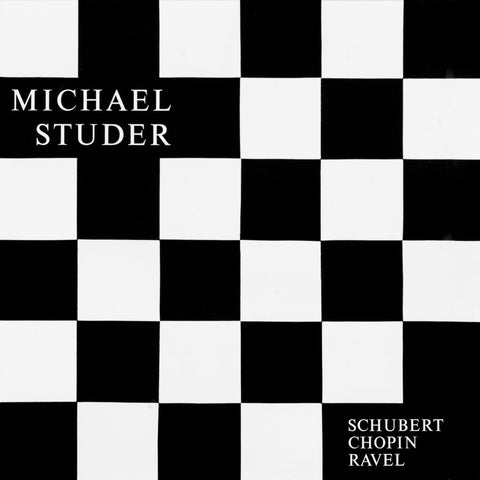(2015) Schubert : Winterreise D 911 - Stephan Genz, Michel Dalberto
Category(ies): Oper vocal Piano
Instrument(s): Piano
Vocal(s): Baryton
Main Composer: Franz Schubert
CD set: 1
Catalog N°:
CD 1606
Release: 10.10.2015
EAN/UPC: 7619931160627
- UPC: 191018814878
This album is now on repressing. Pre-order it at a special price now.
CHF 18.50
This album is no longer available on CD.
This album has not been released yet. Pre-order it from now.
CHF 18.50
This album is no longer available on CD.
CHF 18.50
VAT included for Switzerland & UE
Free shipping
This album is no longer available on CD.
VAT included for Switzerland & UE
Free shipping
This album is now on repressing. Pre-order it at a special price now.
CHF 18.50
This album is no longer available on CD.
This album has not been released yet.
Pre-order it at a special price now.
CHF 18.50
This album is no longer available on CD.
CHF 18.50
This album is no longer available on CD.
SCHUBERT : WINTERREISE D 911 - STEPHAN GENZ, MICHEL DALBERTO
Schubert had already set Wilhelm Müller’s poetic cycle “Die schöne Müllerin” in 1823, and at some point he came across twelve new poems by Müller entitled “Wanderlieder … Die Winterreise” that had been published in the Urania almanac in Leipzig. He set them to music in early 1827. Not long afterwards, Schubert discovered that Müller had meanwhile added another twelve poems to form a larger cycle, publishing them collectively as “Die Winterreise” in a volume called “Poems from the posthumous papers of a travelling horn player”. In order to give his cycle more of a coherent narrative, Müller had juggled the order of his original twelve, mixing some of the new poems among them. But Schubert decided to leave his first twelve songs as they were, and in the late summer of 1827 simply set the new twelve poems to music in the order in which they appeared in Müller’s expanded cycle (the exceptions being “Mut” and “Die Nebensonnen”, which he swapped around). Schubert’s first group of twelve Winterreise songs was published by Haslinger in Vienna in early 1828. The proofs of the second dozen did not arrive until the late autumn. Schubert corrected them when he was already on his deathbed, and by the time the songs were published in December 1828, its composer had been dead for a month.
There is a narrator in the Winterreise, but not much of a narrative. Rejected by the woman he loves, the wanderer leaves home at night. He wanders past haphazard reminders of his lost love – the house where she lived, the linden tree into whose bark he’d carved his sweet nothings, the meadow where once they’d strolled together, then a post coach that he hopes might carry word from her (but doesn’t). A crow circles above as he wanders on. Dogs bark angrily as he crosses a village, he finds himself in a cemetery, and at the end he goes off with a barefoot hurdy-gurdy man who might or might not be real, but in any case represents death. Yet apart from the beginning and the end, there is little that is linear about any of this – not least because of Schubert’s refusal to bend to the final order of Müller’s cycle. Instead, Schubert offers us a depiction of a fractured, spiralling consciousness in which present, past and future intermingle. The wintry weather offers its signifiers of decay and dying throughout – the frozen tears, the falling leaves, the fir trees bent to the wind, the snow blowing in the wanderer’s face and his hair turned white from frost. The environment, both natural and emotional, is more important here than any story.
“I arrived a stranger, and I leave a stranger”. These opening words of Schubert’s Winterreise (“Winter journey”) succinctly sum up the cycle as a whole: it is the quintessential Romantic work about an itinerant outsider, unlucky in love, whose inevitable goal on his journey is always death.
Schubert had already set Wilhelm Müller’s poetic cycle “Die schöne Müllerin” in 1823, and at some point he came across twelve new poems by Müller entitled “Wanderlieder … Die Winterreise” that had been published in the Urania almanac in Leipzig. He set them to music in early 1827. Not long afterwards, Schubert discovered that Müller had meanwhile added another twelve poems to form a larger cycle, publishing them collectively as “Die Winterreise” in a volume called “Poems from the posthumous papers of a travelling horn player”. In order to give his cycle more of a coherent narrative, Müller had juggled the order of his original twelve, mixing some of the new poems among them. But Schubert decided to leave his first twelve songs as they were, and in the late summer of 1827 simply set the new twelve poems to music in the order in which they appeared in Müller’s expanded cycle (the exceptions being “Mut” and “Die Nebensonnen”, which he swapped around). Schubert’s first group of twelve Winterreise songs was published by Haslinger in Vienna in early 1828. The proofs of the second dozen did not arrive until the late autumn. Schubert corrected them when he was already on his deathbed, and by the time the songs were published in December 1828, its composer had been dead for a month.
There is a narrator in the Winterreise, but not much of a narrative. Rejected by the woman he loves, the wanderer leaves home at night. He wanders past haphazard reminders of his lost love – the house where she lived, the linden tree into whose bark he’d carved his sweet nothings, the meadow where once they’d strolled together, then a post coach that he hopes might carry word from her (but doesn’t). A crow circles above as he wanders on. Dogs bark angrily as he crosses a village, he finds himself in a cemetery, and at the end he goes off with a barefoot hurdy-gurdy man who might or might not be real, but in any case represents death. Yet apart from the beginning and the end, there is little that is linear about any of this – not least because of Schubert’s refusal to bend to the final order of Müller’s cycle. Instead, Schubert offers us a depiction of a fractured, spiralling consciousness in which present, past and future intermingle. The wintry weather offers its signifiers of decay and dying throughout – the frozen tears, the falling leaves, the fir trees bent to the wind, the snow blowing in the wanderer’s face and his hair turned white from frost. The environment, both natural and emotional, is more important here than any story.
Return to the album | Read the booklet | Composer(s): Franz Schubert | Main Artist: Stephan Genz







